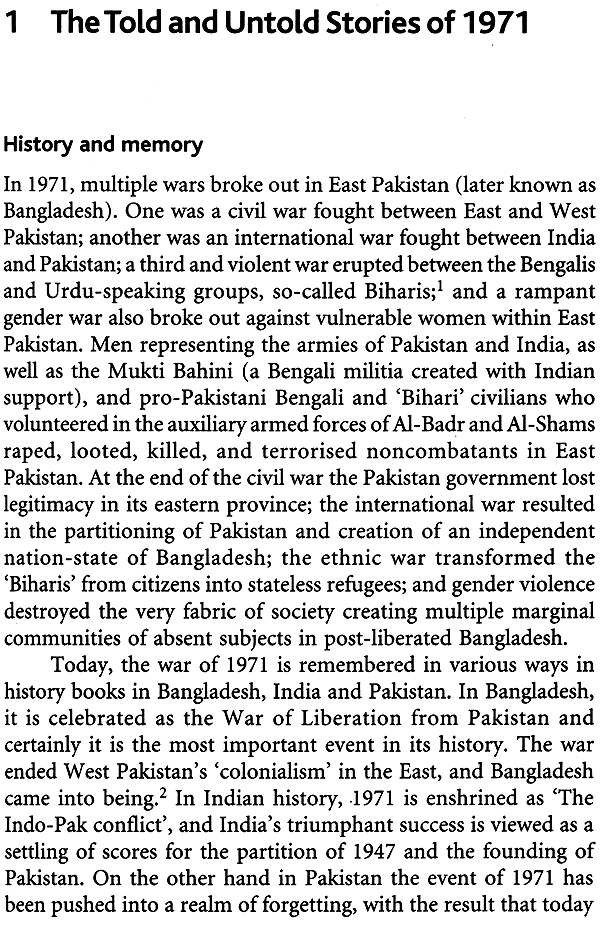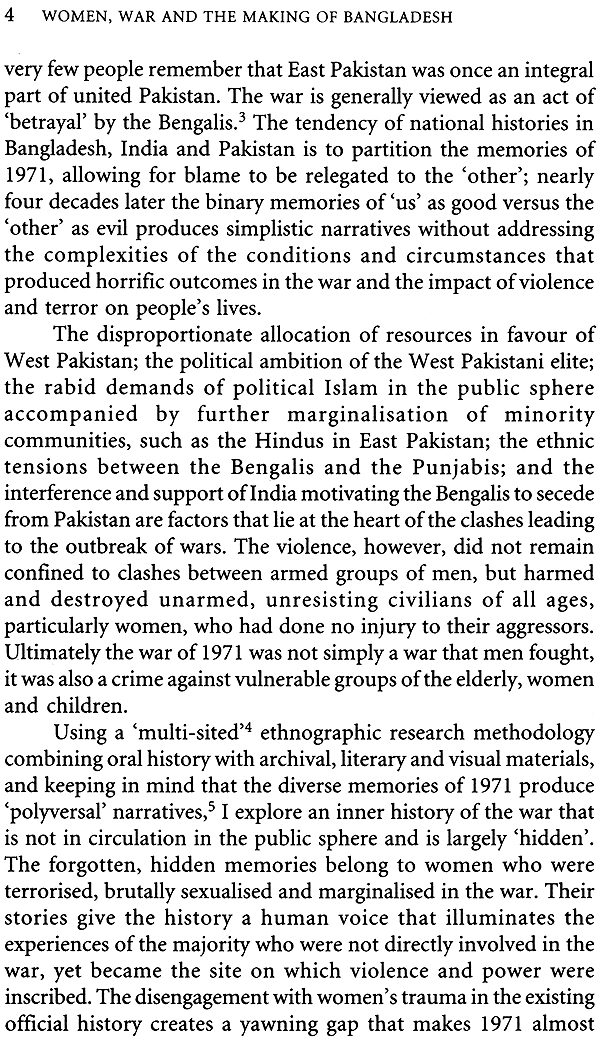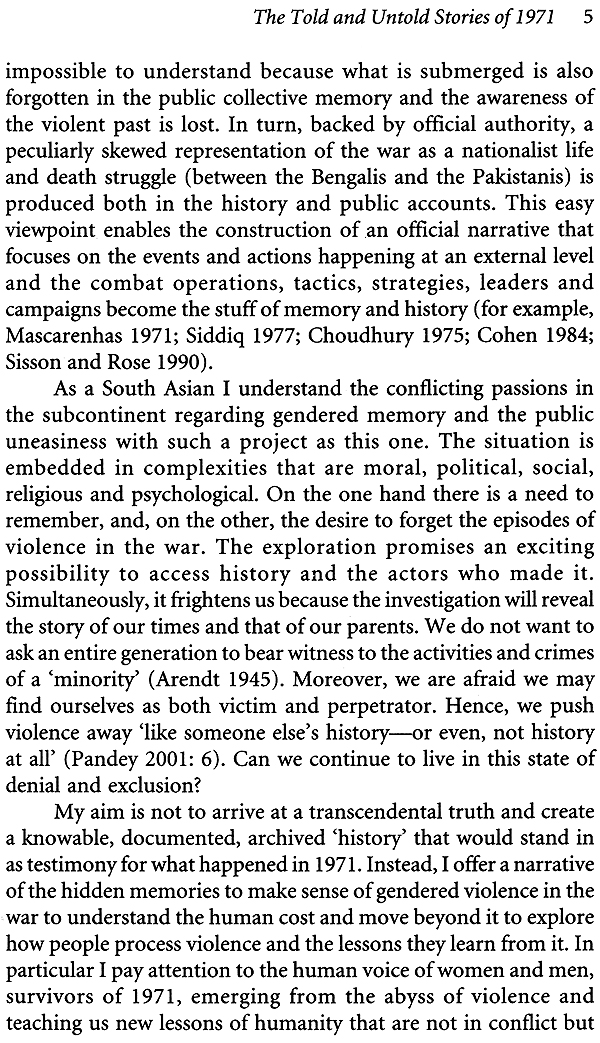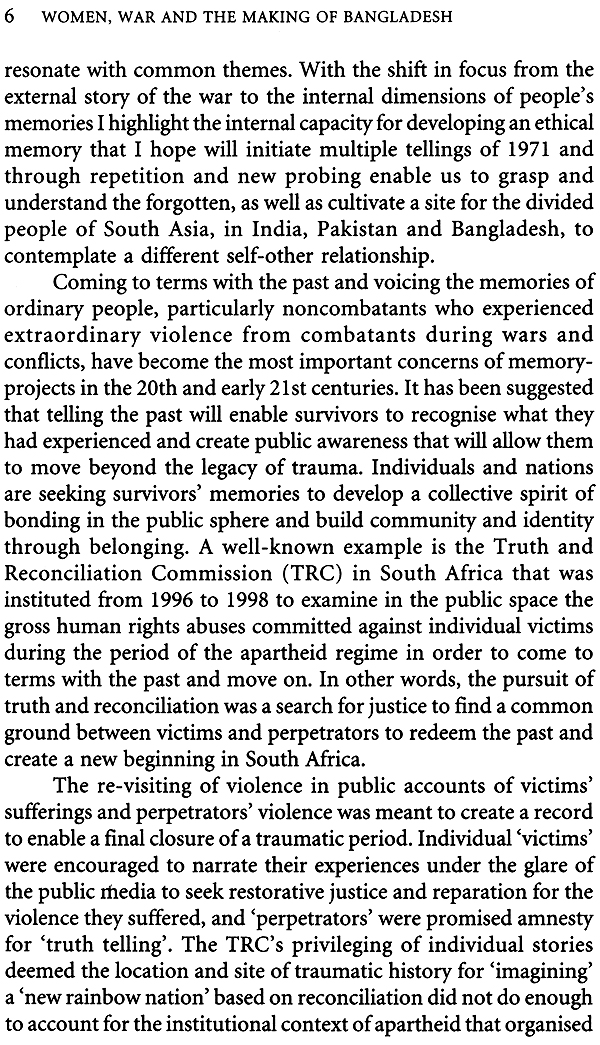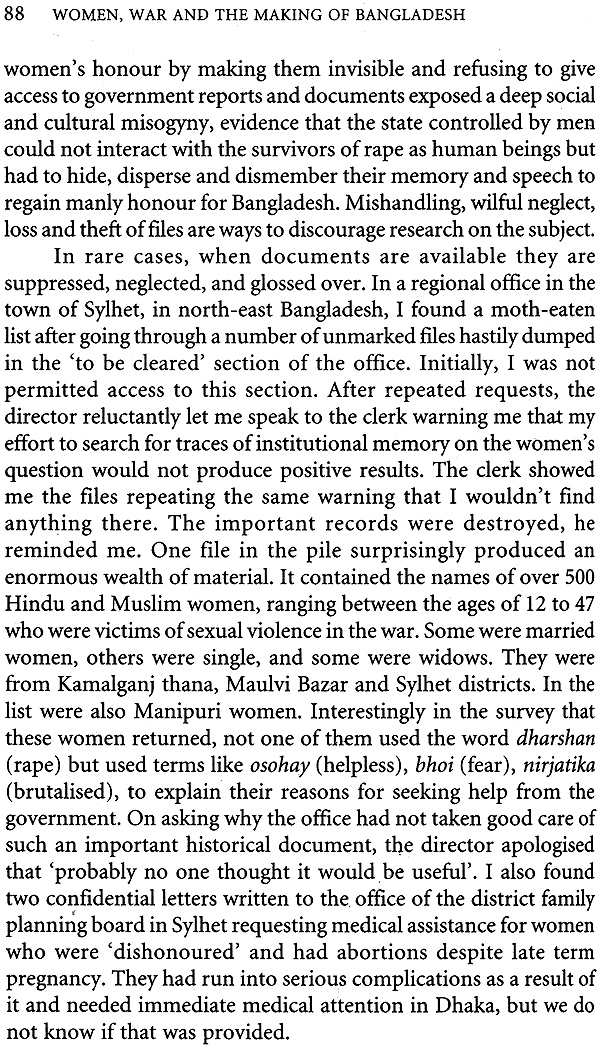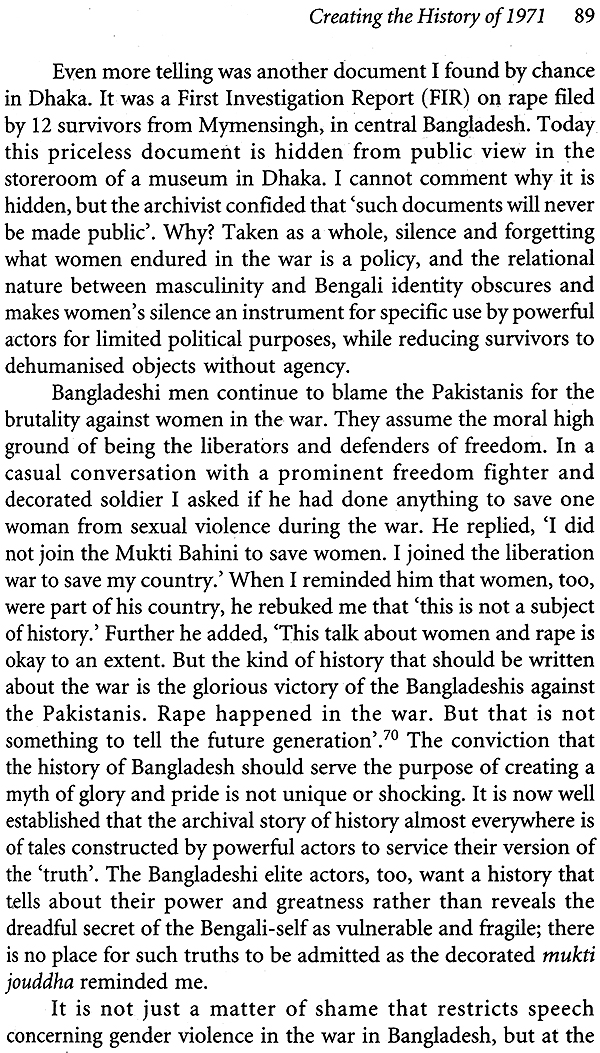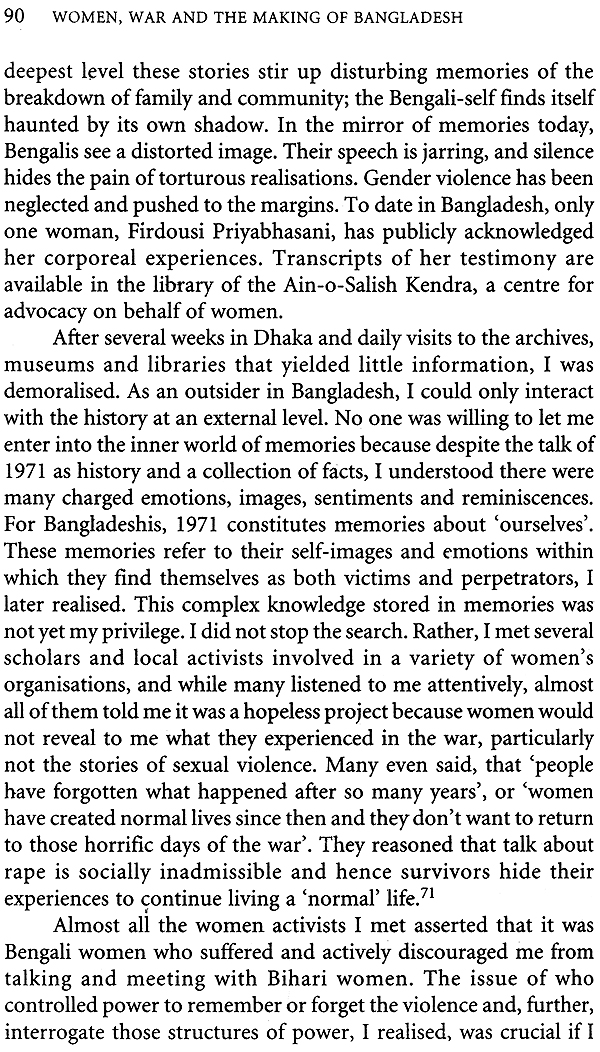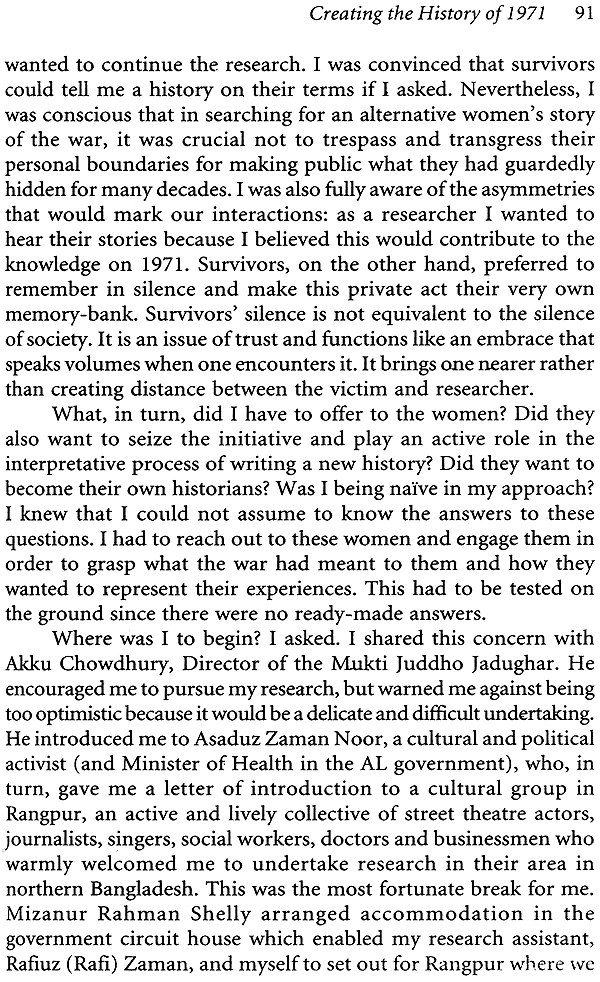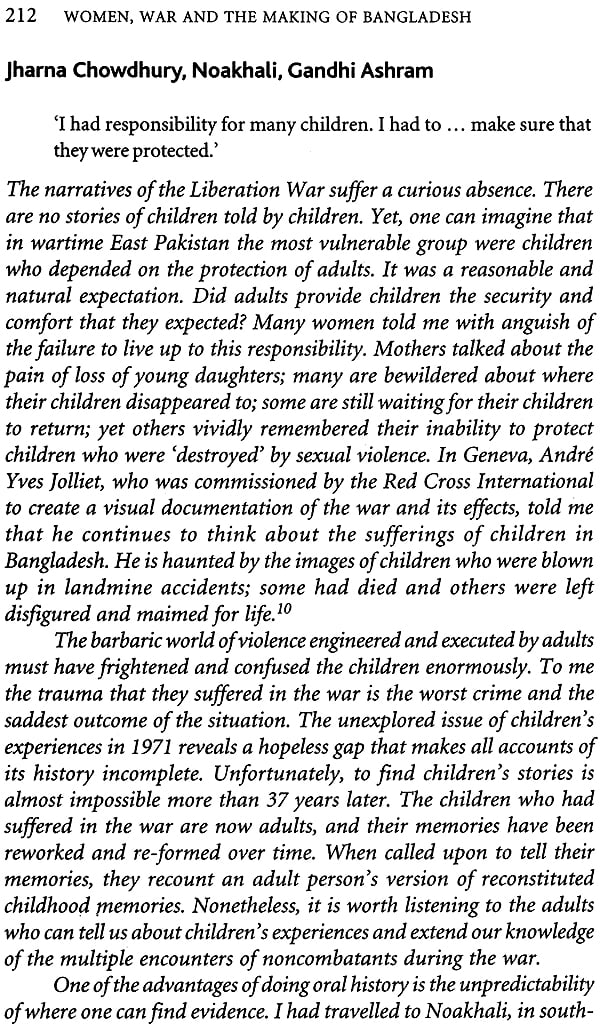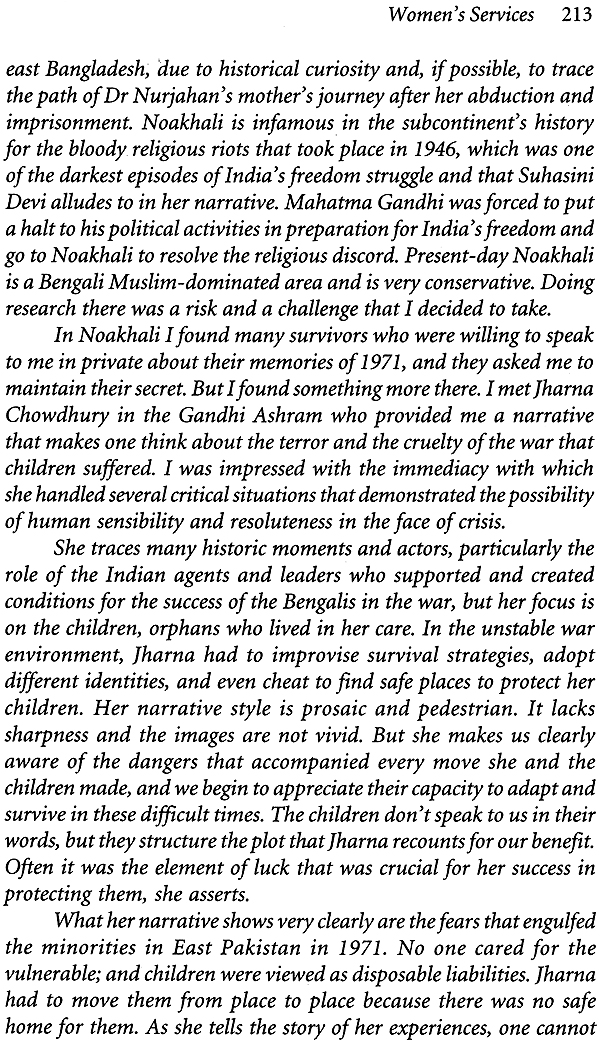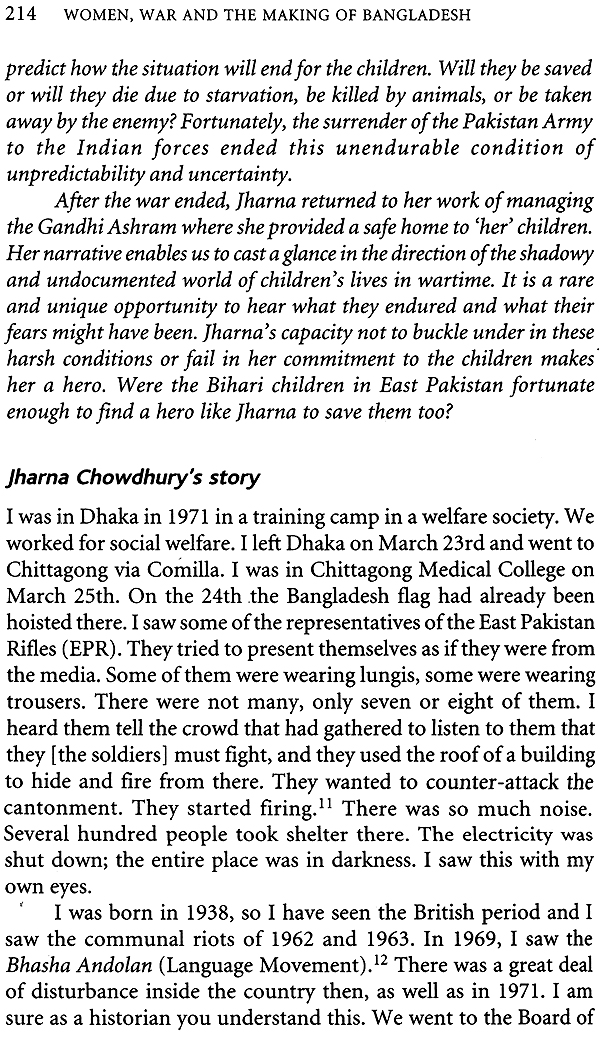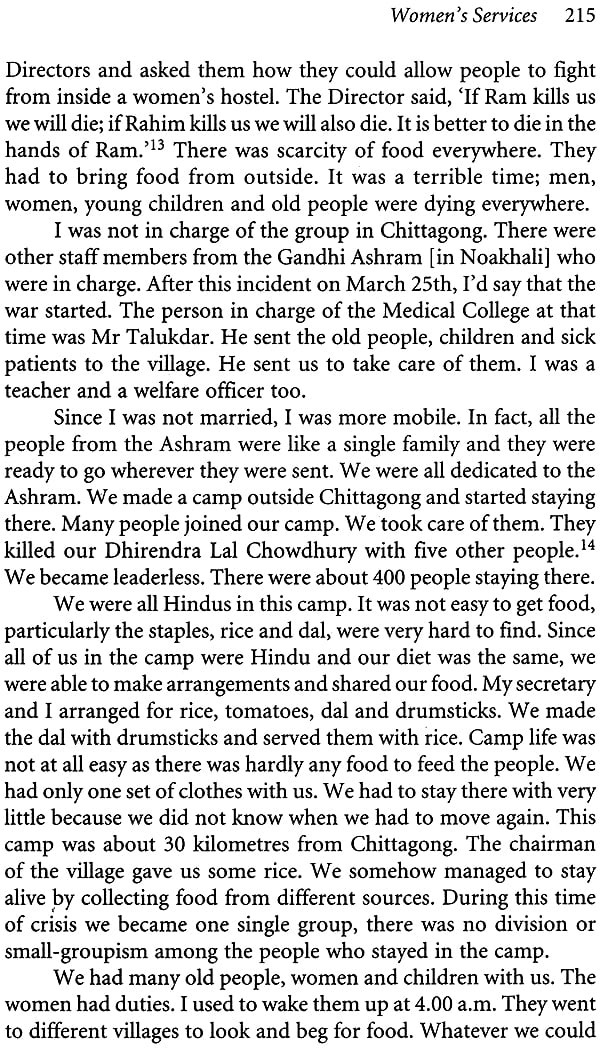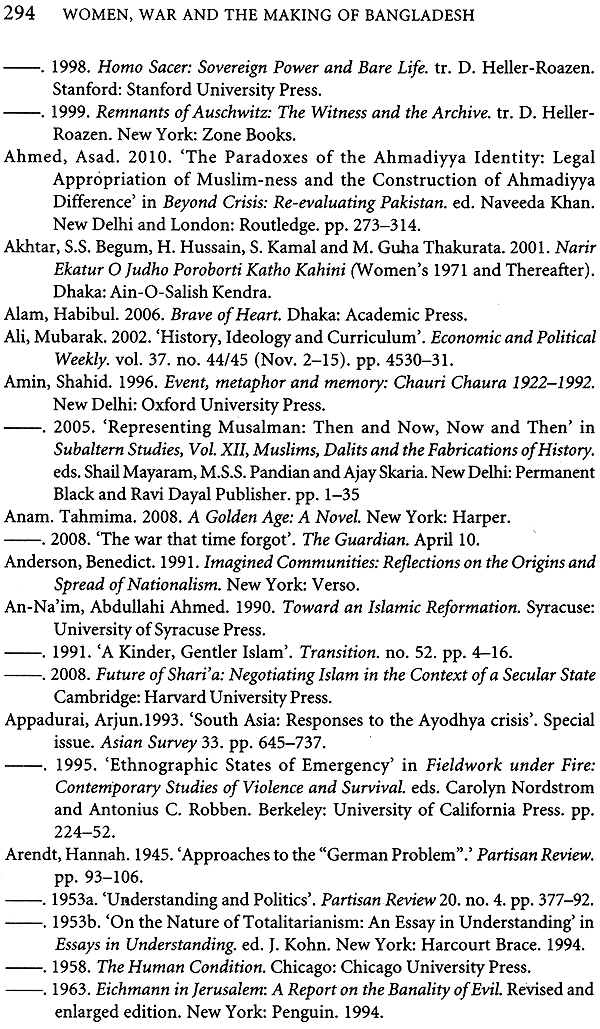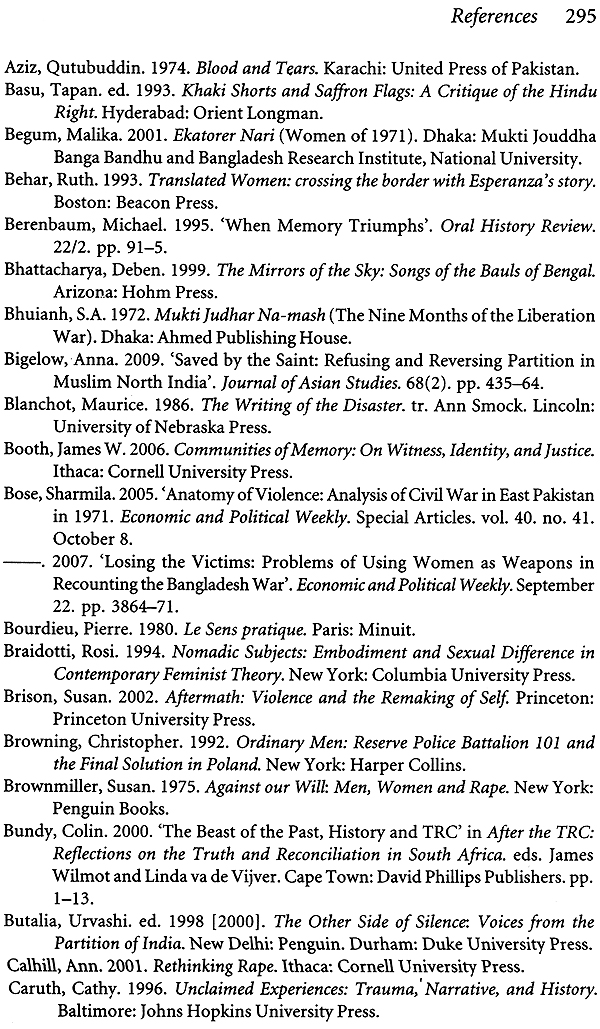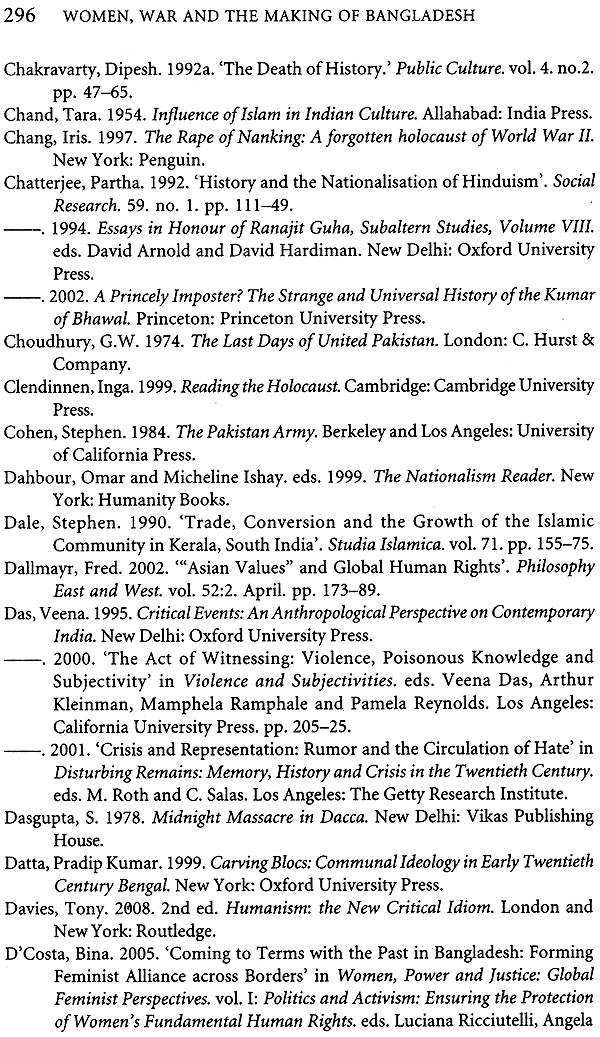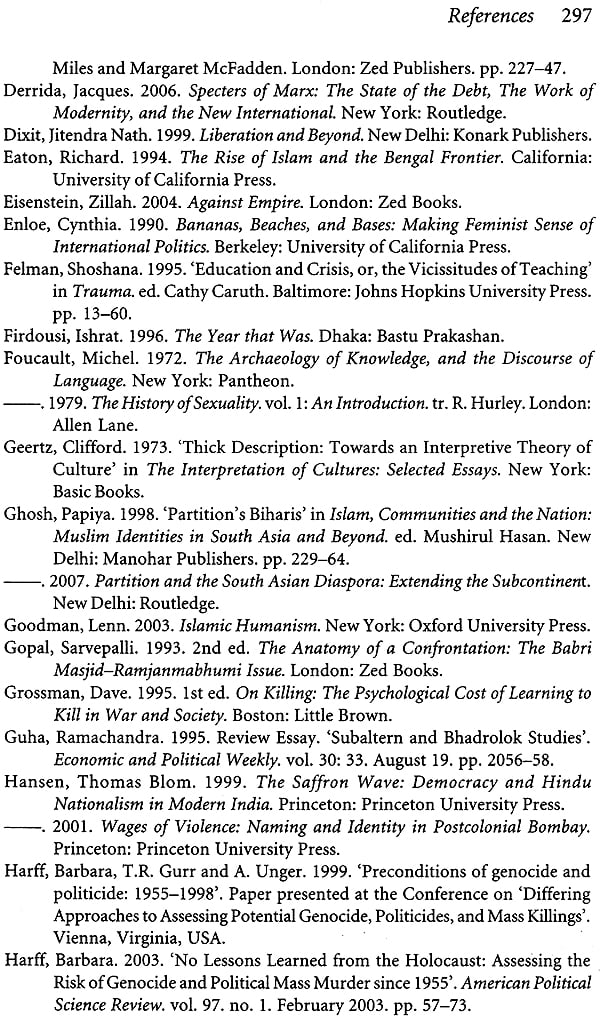
Women War and The Making of Bangladesh ( Remembering 1971)
Book Specification
| Item Code: | NAG206 |
| Author: | Yasmin Saikia |
| Publisher: | Women Unlimited |
| Language: | English |
| Edition: | 2011 |
| ISBN: | 9788188965458 |
| Pages: | 326 |
| Cover: | Hardcover |
| Other Details | 8.5 inch X 5.5 inch |
| Weight | 540 gm |
Book Description
About the Book
Nationalist histories of liberation or independence are often accounts of heroic resistance and victory. But what is the relationship between nationalism and violence? Is it possible to move beyond demarcated histories of nations and states in South Asia and reconsider a people's narrative of 1971?
Based on several oral accounts, this book traces the multiple experiences of Bangladeshi women in the 1971 war that led to the creation of Bangladesh, where it is remembered as the War o Liberation. The voices in this book are new and original. Survivors tell their stories, revealing the power of speaking of what is deemed unspeakable. Women talk of rape and torture on a mass scale, of the loss of status and citizenship, and of war babies born after 1971. They also speak of their role as agents of change, as social workers care givers and wartime fighters. From them we learn firsthand of the horrors of violence, and of the unfinished business of the partition of 1947 that surfaced, once again, in 1971.
In addition, a few men recollect their wartime brutality as well as their post war efforts to regain a sense of humanity, to reconcile and heal unresolved traumas.
This book sheds new light on the relationship between nation, history and gender in postcolonial South Asia, by not only interrogating the making of a new nation, but simultaneously posing a challenge to post 1971 historiography in Bangladesh, highlighting the many absences in the official and unofficial histories offered so far.
About the Author
Yasmin Saikia is Hardt Nickachos Chair in peace Studies and professor of History, Arizona State University. She is the author of numerous articles and a book, Assam and India Struggling to be Tai Ahom in India (2004) which was awarded the Srikanta Datta prize for best book on north east India by the Nehru memorial Museum and Library, New Delhi.
Preface
South Asia, a term coined by the United States government in the post-cold-war era, was quickly adopted in academic circles. In 1964, the Centre of South Asian Studies opened in Cambridge University. Today, the terms 'South Asia' and 'Indian subcontinent' are used interchangeably with the emphasis, of course, on Indian Studies, which is the primary focus of most scholarly research and writing. In 1999, when I was appointed the first Assistant Professor of South Asian History at the University of North Carolina-Chapel Hill, no one asked me nor did I understand the implication of this newfound responsibility. I had studied Indian history for several years in India and the United States. But South Asian History was more than this and it meant learning and studying this on my own in order to teach it to my students once I had some grasp of the region and its multilayered, multifaceted history. The best way to learn about the people and place was to travel and listen to people tell history through their experiences?
As a person of Indian origin, travel to Pakistan was a little tricky and the outbreak of the Kargil war in 1999 made people to people interaction more complicated and difficult. Bangladesh, on the other hand, was a little less threatening. Being close to my home state of Assam I was somewhat familiar with the Bengali language and people with whom we share a love hate relationship, but beyond this acquired politics of identity I had a personal connection as well. My father had studied at Dhaka University for several years and his memories transmitted to me made me curious to travel there. The relationship between India and Bangladesh being semi-friendly enabled me to obtain a visa and I visited Dhaka in summer 1999 before I started my teaching job.
I decided my first visit would be to the Dhaka University in memory of my father but instead I was taken to a 'forbidden' place called Camp Geneva where the 'stateless' Bihari community lives. The residents were very curious about me and some were even hostile. Once they heard me speak in Urdu (their mother tongue), they recognized I was not a Bengali and many welcomed me to listen to their saga of misery after the war of 1971 and their present status as people without identity. While I was speaking with two middle-aged women, outside their shack, a young man, the son of one of the women, came up and said, 'My parents will go to their graves without anyone knowing their story. Why must we suffer for the crimes of another generation?' This question stunned me.
Instantly, I realized that for a community living under the negative power of history's politics it is not a subject of research and study, but a burdensome inheritance filled with hidden memories. This chance encounter motivated me to find and write a history of South Asia, not about its made-up glorious past and its rich legacy of semi-mythical heroes but by looking for heroes in people who experienced this history and can talk about it. Also, it became clear to me that 1971 is a very appropriate beginning for investigating such a history because it is a unique moment; this was the only instance after the end of British colonialism when the people and governments of the Indian subcontinent India, Pakistan and Bangladesh encountered each other. The encounter was not friendly or nostalgic but designed and expressed violence and terror. Since then the three nation-states of the subcontinent never shared a common moment together.
For several years, from 2001 onwards, I spent extended periods of time in Bangladesh, Pakistan and India meeting and talking, listening and sharing with people their stories of the war. It was a journey into deep pain and unforgettable memories of loss; but also of incredible resilience and heartening human compassion. Every time I despaired about the South Asian human community, I was immediately reminded of the inexhaustible source of human endurance and respect for fellow human beings, and I became intimately aware of the capacity of good and evil within us. History was no longer someone else's story or a project for teaching, research and getting tenure, it was a personal encounter to know and became implicated in the common story of the past and present and learn to share the space with one another. Refracting from the moment and memories of 1971 I have tried to convey the message of a common human narrative that survivors share with us.
In the book, I focus on the story of gender violence in the 1971 war of Bangladesh to probe the relationship between nation, history and women one of the most vulnerable groups in postcolonial South Asia. Moving beyond the external story of the war as a clash of ideologies and struggle for power between rivals India and Pakistan and East and West Pakistan, I tell the story of the war as a human event of individual losses and personal tragedies suffered by both women and men. Their individual stories articulate a collective loss of humanity (insaniyat) that transcends the politics of history and nation. Combining oral testimony with archival research in India, Pakistan and Bangladesh I weave together the social, political and cultural history of the subcontinent after the partition of India and Pakistan in 1947 to show the gaps between people and their governme3nts, memories and history. By privileging oral testimonies of 1971 survivors, I seek to shine a spotlight on heroes we do not know of and on their suppressed and hidden memories for recovering a people's history. It is important to study violence and know it ethically and personally to develop a human language for reconciliation between victims and perpetrators women and men, as well as the countries of India, Pakistan and Bangladesh.
I have divided the book into three parts. Part I, 'Introducing 1971' consists of 'The Told and Untold Stories of 1971' and 'Creating the History of 1971'. In this, I engage the theoretical and methodological issues of writing about violence from a South Asian viewpoint and tell the story as people experienced it as a way of decolonizing the narrative of postcolonial history and claim agency to enable 'us' to accept the good and bad within 'our' history. In emphasizing a cultural methodology to write the story of violence, I stress the forgotten pr-modern exchanges and dialogues between the Sufi-Bhakti traditions that had generated a vocabulary of insaniyat and shared responsiveness for enabling humanization that was undermined in the violence in 1971. I show how women invoke the capacity to remember and enable a new narrative highlighting women's humanity despite the violence they suffered.
From a theoretical standpoint, I privilege the investigation of the 1947 partition and its representation by South Asian scholars and I weave my story of 1971 with theirs to continue the conversation how to write a history of violence in South Asia within its shared cultural and historical experiences. To show that the South Asian case is neither unique nor exclusive, I have drawn upon the literature on the Holocaust, Truth and Reconciliation in South Africa, and genocides in Rwanda and Darfur that make evident the widespread nature of violence and connect the multiple stories as experienced by people in many different parts of the 20th century world. In the concluding section, I draw on the concept of forgiveness by highlighting the Islamic concept of huqquq al-ibad (human rights) and individual responsibility to suggest closure of the traumatic violence of 1971.
Part II 'Survivors speak' includes three subsections 'Victims' Memories', 'Women's services', and 'Woman's War'. This is the heart of the book, the story of how women experienced the war. Their stories are rich and varied and they narrate their experiences in polyversal narratives that continuously make us aware of the attack on the feminine self that was under siege during the war but could not be destroyed. Besides the stories of victims, birangonas (a term coined in 1972 to recognize the rape survivors of the war),I also include the voices of women who worked in multiple capacities during the war as active participants giving care and support to victims and survivors, and, in addition, joined the war efforts as soldiers. The latter section of women as warriors is particularly useful because it shows them as aggressors capable of doing the same violent acts as men did in the war, with the exception of rape.
The testimonies in the first section are produced verbatim with slight modifications, eliminating repetition and some redundancies when necessary. The names of the women are pseudonyms unless someone explicitly requested using her real name. Even then, I have tried not to give details about the individual because of the sensitive nature of the testimonies that may lead to women's further marginalization for speaking out against the established official narrative and due to social and religious backlash in a conservative Muslim society such as Bangladesh.
The five testimonies focus on rape and its impact, including one of a war baby who was born of the violence of rape Beauty, the daughter of Nur Begum. Beauty is our most important interlocutor because it is her generation born out of the war that asks us to face the true consequences of suffering a violent history. Choosing these five narratives of rape from a vast collection of more than 50 that I recorded in Bangladesh was a difficult decision. These narratives are not unique or unusual compared to the others that are not recounted here. In fact, they are just like the others and it was their representational characteristics that helped me make the decision to use them in the book. They span the concerns of the individual alongside the collective and raise critical questions about witnessing.
'Women's Services', the second section, includes three narratives of women who served in the war efforts as social workers and in the government abortion programme after liberation. The social workers and medical professionals in Bangladesh belonged to both the Hindu and Muslim Bengali communities. As such, their communal affinities restricted and confined their work to their own communities, thereby making the healing process after the war a limited Bengali experience. Nonetheless, their direct intervention in the post war efforts enabled Bengali women to recreate and reconvene somewhat normalized lives. Women's work as social healers and care-givers is crucial in understanding the post war period and women's role in enabling the new and independent nation of Bangladesh.
The final section, 'Women's War', constitutes the memories of women as soldiers. The two narratives here shift our focus from women as victims and healers to the more active role that they played in the war as combatants. This is an important issue to consider when we revisit 1971and the experiences of Bengali women who were both victims and agents of violence acted on by others as well as acting on their own volition to fight on behalf of the nation. In listening to their narrat5ives, we are painfully reminded of two women's passion and determination that motivated them to jump into the thick of battle and the subsequent discrimination that they suffered because of their gender in the male dominated turf war, so that neither of them has received official recognition as mukti jouddhas (war heroes). Their story is not uncommon; the vast majority of women who served in the freedom struggle of Bangladesh have been hustled away into silence and remain unrecognized.
These narratives bring to light the experiences of violence that women suffered and their resilience that make it possible to write a new history of 1971 after the war. Women's resilience and refusal to forget combine to serve the most useful function, to make the illegible legible and generate a new register of memory that is able to address pain and show the possibility of hope for a new and different beginning after the violence and war. This in my estimation is women's unique strength, and I highlight their ability to not become fixed in their 'victim' status but represent themselves as creative builders and architects of family, society and community.
Since their question are not limited to their condition in isolation, but make us aware of sexual violence as a crime committed by men's abuse3 of power, they enabled me to 'see' the horizon of the research. Rather than arriving at a conclusion the research expanded to include another new angle. The exploration of men's memories became a new research project in consequence and I share this process with my readers.
The initial entry and hiccups in undertaking research on perpetrators memories is introduced in part III, 'A New beginning'. I contextualize men's memories in brief excerpts to evaluate what happened to Pakistani soldiers, Bengali Mukti Bahini guerillas and ordinary militia men who learned crucial lessons of their fragile human status in committing violence. By highlighting the stages of changes in men becoming perpetrators and turning the narrative back to their humanity, I do not seek to exonerate men for committing crime. I listened and present their stories to show how personal encounters with violence taught perpetrators lessons that made them reconsider the contingent nature of external identities informed by religion, nation, and ethnicity, and focus on the unmarked ground of humanity in the subcontinent. This momentary unmarking enables interrogation of structures like nation, state and national identity and creates a language of acknowledgement to reach closure of the event of violent history. The perpetrators' ability to acknowledge the violence committed against another human being is the most powerful statement delivering justice to their victims that no court of law or state can do. This we need to listen to in order to move forward in the subcontinent and develop better understanding among the people for a just and better future in the region.
Contents
| Acknowledgements | ix | |
| Preface | xiii | |
| Part I: Introducing 1971 | ||
| 1 | The Told and Untold Stories of 1971 | 3 |
| History and memory | 3 | |
| Locating the scholarship | 17 | |
| A short not on history writing in south Asia | 30 | |
| 2 | Creating the History of 1971 | 45 |
| The politics of Pakistan and India | 45 | |
| Violence on the side: war on noncombatants | 54 | |
| Becoming aware | 75 | |
| Research chronicle | 81 | |
| Tracking 1971 with the memories of women | 92 | |
| Women's humanity | 109 | |
| Part II: Survivors Speak | ||
| 3 | Victims' Memories | 137 |
| Nur Begum and Beauty, Rangpur | 137 | |
| Firdousi Priyabhasani, Dhaka | 152 | |
| Taslima's mother, Dinajpur | 167 | |
| Nurjahan Begum and a group of Bihari women, Khulna | 178 | |
| 4 | Women's Services | 191 |
| Suhasini Devi, Sylhet | 191 | |
| Dr Syed Ahmed Nurjahan, Chittagong | 202 | |
| Jharna Chowdhury, Noakhali, Gandhi Ashram | 212 | |
| 5 | Women's War | 225 |
| Laila Ahmed, Rajshahi and Dhaka | 225 | |
| Mumtaz Begum Jessore | 244 | |
| Part III: A New Beginning | ||
| 6 | Postscriopt: Lessons of Violence | 261 |
| Reference | 293 |
